Barber J.R. Intermediate Mechanics of Materials
Подождите немного. Документ загружается.

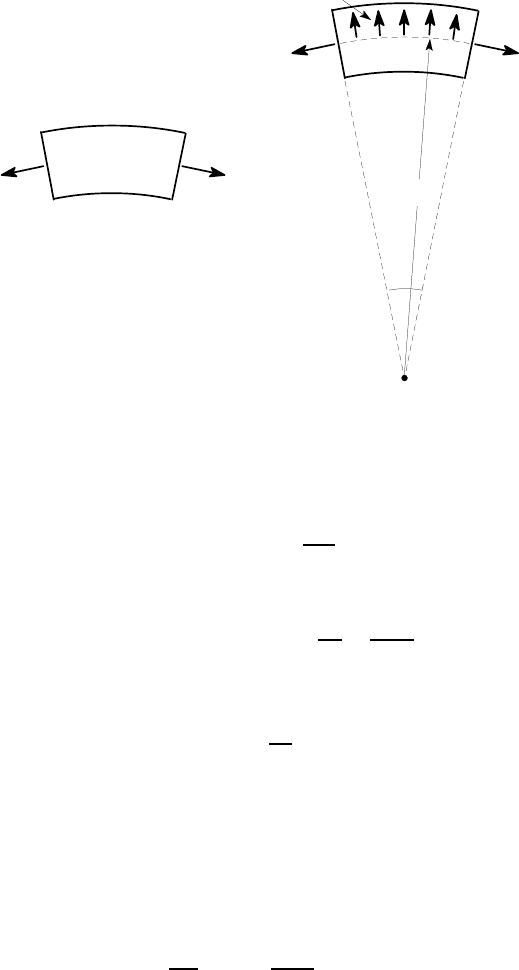
11.1 The governing equation 495
F
F
δθ
O
R
F
F
w per unit length
(a) (b)
Figure 11.6
Neglecting Poisson’s ratio effects from the stress components
σ
rr
,
σ
zz
, we then
have
σ
θθ
= Ee
θθ
=
Eu
r
r
(11.18)
corresponding to an axial force
F =
ZZ
A
σ
θθ
dA = Eu
r
ZZ
A
dA
r
=
EAu
r
ˆr
, (11.19)
using (11.7). Eliminating u
r
between equations (11.18, 11.19) gives
σ
θθ
=
F ˆr
Ar
. (11.20)
We can find the line of action of the force F by taking moments about the axis of
curvature O. We find
M
O
=
ZZ
A
σ
θθ
rdA = Eu
r
ZZ
A
dA = EAu
r
.
It follows that the force passes through a point a distance
M
O
F
= EAu
r
ˆr
EAu
r
= ˆr
from O. In other words, the force for this simple mode of deformation passes through
the neutral surface of the bending analysis.
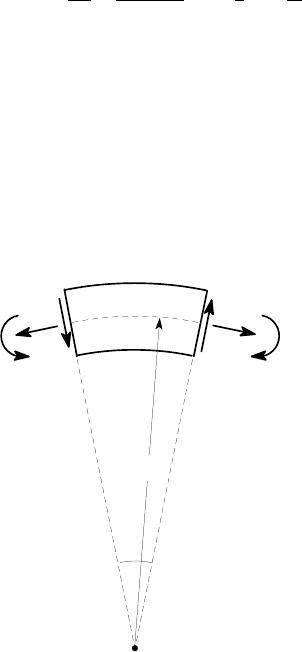
496 11 Curved Beams
This represents the most natural decomposition of the load into a force and a mo-
ment, since the force then produces no rotation of transverse planes and the moment
causes no extension of the fibre located at the line of action of the force. However,
simpler expressions are obtained if we consider the stress field due to a force whose
line of action passes through the centroid (r = ¯r) of the section. This loading can be
regarded as the superposition of a force F acting through r= ˆr and a bending moment
M = F(¯r−ˆr). The resulting stress field is then
σ
θθ
=
F ˆr
Ar
+
F(¯r − ˆr)
A(¯r − ˆr)
1 −
ˆr
r
=
F
A
. (11.21)
Thus, if the line of action of the force passes through the centroid, the stress
distribution is uniform and equal to F/A as in the elementary bending theory, but the
deformation will then involve a non-zero value of d
φ
/d
θ
.
More general loading
If there is an axial force, but no radial load, the bending moment and the transverse
shear force in the beam must vary along the beam. The corresponding beam segment
is shown in Figure 11.7.
δθ
O
R
F
V
F+δF
V+δV
M
M+δM
Figure 11.7
Resolving forces in horizontal and vertical directions and taking moments about
the centre of curvature O, we obtain the three equilibrium equations
δ
F +V
δθ
= 0 ;
δ
V −F
δθ
= 0 ; R
δ
F +
δ
M = 0
and hence, in the limit
δθ
→0,

11.1 The governing equation 497
dF
d
θ
= −V ;
dV
d
θ
= F ;
dM
d
θ
= R
dF
d
θ
= −RV . (11.22)
The first two equations can be combined to yield
d
2
F
d
θ
2
+ F = 0 ;
d
2
V
d
θ
2
+V = 0 (11.23)
and hence the most general solution for F,V, M in the absence of distributed loads is
F = A cos
θ
+Bsin
θ
; V = A sin
θ
−Bcos
θ
; M = ARcos
θ
+BRsin
θ
+C, (11.24)
where A,B,C are three constants to be determined from the end loading conditions.
The shear force V will generally cause initially plane transverse sections to de-
form out of plane and hence the preceding analysis is strictly not appropriate to this
case. However, as with straight beams, the stresses associated with the shear force
are generally fairly small and the simpler results can be used for general loading
without much loss in accuracy.
Example 11.2
Figure 11.8 shows a U-shaped curved beam with a symmetric channel cross section,
loaded by two opposed forces of magnitude 2kN. Find the neutral radius ˆr associated
with this cross section and the maximum tensile stress at the section A−A.
20
O
2 kN
2 kN
100
50
A
A
10
5 5
20
20
20
c
L
Section A-A
all dimensions in mm
Figure 11.8
The cross section is conveniently regarded as the difference between the solid
(30×30) square and the dotted (20×20) square in Figure 11.9.

498 11 Curved Beams
20
20
c
L
20
30
30
all dimensions in mm
Figure 11.9
For the 30 ×30 square, (A
1
), we have
A
1
= 900 mm
2
, a = 20 mm, b = 50 mm, ¯r
1
=
a + b
2
= 35 mm, t = 30 mm
and
ZZ
A
1
dA
r
= t ln(b/a) = 27.4887 mm,
from (11.8).
For the 20 ×20 square (A
2
),
A
2
= −400 mm
2
, a = 30 mm, b = 50 mm, ¯r
2
= 40 mm, t = 20 mm
and
ZZ
A
2
dA
r
= −10.2165 mm.
These results are conveniently tabulated as in §4.3 as
i 1 2
A
i
900 –400
¯r
i
35 40
ZZ
A
i
dA
r
27.4887 –10.2165
We then have
A = A
1
+ A
2
= 900 −400 = 500 mm
2
A¯r = 900 ×35 −400 ×30 = 15500 mm
3
¯r =
15500
500
= 31 mm
ZZ
A
dA
r
= 27.4887 −10.2165 = 17.2722 mm.
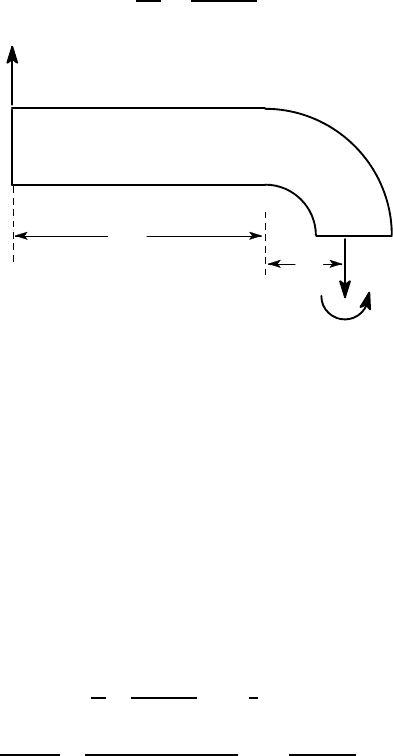
11.2 Radial stresses 499
and the neutral radius, ˆr is therefore
ˆr = A
ZZ
A
dA
r
=
500
17.2722
= 28.9483 mm.
2 kN
100
A
A
31
F
M
all dimensions in mm
Figure 11.10
Figure 11.10 shows a free-body diagram of the beam sectioned at A−A, at which
there will be an axial force F =2 kN and a bending moment, referred to the centroidal
radius ¯r = 31 mm of
M = 2(100 + 31) = 262 Nm (kNmm).
The direction of the bending moment in Figure 11.10 is opposite to that in Figure
11.1 (a), so we must take M = −262 Nm in equation (11.13). Also, it is clear from
Figure 11.7 that the maximum tensile stress will occur at the inner radius, r=20 mm
and its magnitude is
σ
max
θθ
=
σ
θθ
(20) =
F
A
+
M
A(¯r − ˆr)
1 −
ˆr
r
=
2 ×10
3
500
+
−262 ×10
3
500(31 −28.9483)
1 −
28.9483
20
= 118.3 MPa.
11.2 Radial stresses
In developing equation (11.5), we assumed that
σ
θθ
was the only stress and in par-
ticular that the radial stress
σ
rr
was negligible. In practice, significant radial stresses
can be developed in curved beams, but since their contribution to equation (11.5) is
multiplied by Poisson’s ratio which is fairly small, the above analysis generally gives
a good approximation to the circumferential stresses in the beam.

500 11 Curved Beams
θθ
σ t δr
θθ
σ t δr
rr
σ tr δθ
t+δt
t
r
δθ
δr
rrrr
(σ +δσ )(t+δt)(r+δr)δθ
Figure 11.11: Radial equilibrium of a small beam element
We can estimate the distribution of radial stress by using an equilibrium argu-
ment. We first need to modify the equilibrium equation (10.4) to include the effect
of a variable thickness in the axial direction. Figure 11.11 shows the small element
of the beam contained between the radial surfaces r and r +
δ
r. The equilibrium
equation for this element, analogous to equation (10.1) with no acceleration term, is
(
σ
rr
+
δσ
rr
)(r +
δ
r)(t +
δ
t)
δθ
−
σ
rr
rt
δθ
−2
σ
θθ
t
δ
r sin
δθ
2
= 0 .
Dividing throughout by r
δ
r
δθ
and proceeding to the limit as
δ
r,
δθ
→0, we obtain
the differential equation of equilibrium
d
dr
(t
σ
rr
) +
(
σ
rr
−
σ
θθ
)t
r
= 0 , (11.25)
which clearly reduces to (10.4) if t is independent of r.
Equation (11.25) can be expressed in the form
d
dr
(tr
σ
rr
) = t
σ
θθ
.
The radial stress must be zero at the inner radius r = a and hence we can integrate
this relation to obtain
σ
rr
=
1
tr
Z
r
a
t
σ
θθ
dr , (11.26)
which permits
σ
rr
to be determined, once
σ
θθ
is known.
Example 11.3
Find the maximum radial stress
σ
rr
for the square section curved beam of Example
11.1.
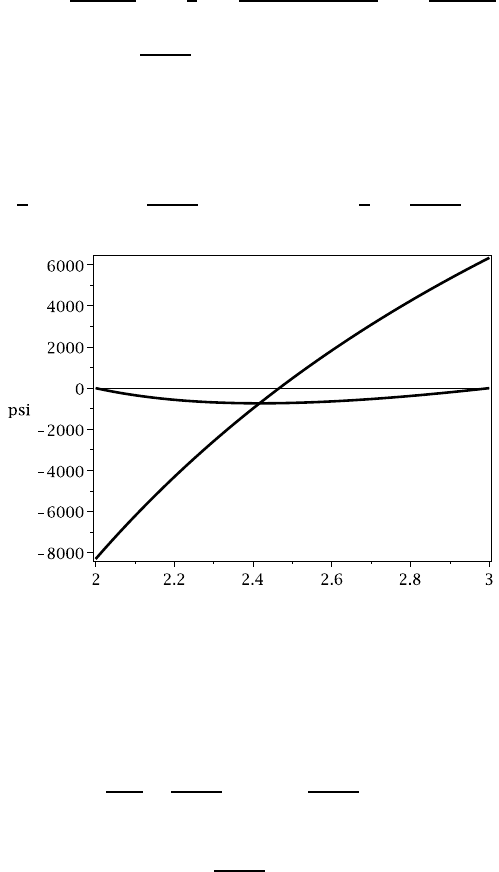
11.2 Radial stresses 501
We already found the radii ˆr, ¯r for this beam in Example 11.1 above as
ˆr = 2.46630 in ; ¯r = 2.5 in
and hence the general expression for
σ
θθ
is
σ
θθ
(r) =
M
A(¯r − ˆr)
1 −
ˆr
r
=
100 ×12
1(2.5 −2.46630)
1 −
2.46630
r
= 35608 −
87821
r
psi,
where r is in inches.
For this geometry, t is constant and equal to 1 in, so substituting for
σ
θθ
into
equation (11.26), we obtain
σ
rr
=
1
r
Z
r
2
35608 −
87821
r
dr = 35608
1 −
2
r
−
87821
r
ln(r/2) .
σ
θθ
σ
rr
r (in)
Figure 11.12: Stress distribution in the square section beam
The stresses
σ
rr
,
σ
θθ
are shown as functions of r in Figure 11.12. The radial
stress is zero at the inner and outer radii, as required by the traction-free boundary
condition, and the maximum value occurs when
d
σ
rr
dr
=
87821
r
2
ln(r/2) −
16605
r
2
= 0
and hence
r = 2exp
16605
87821
= 2.416 in.
The maximum radial stress is therefore
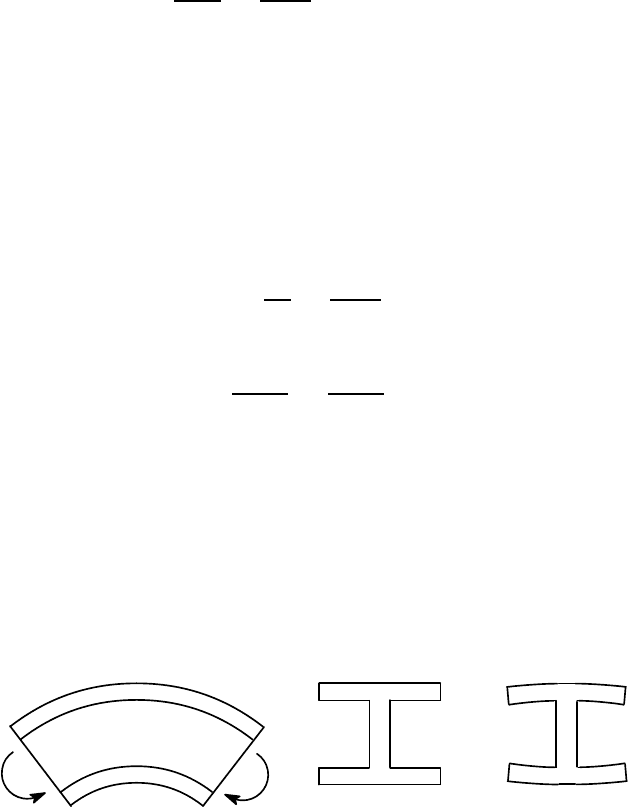
502 11 Curved Beams
σ
max
rr
= 35608
1 −
2
2.416
−
87821
2.416
ln(2.416/2) = −738 psi (compressive).
This is small compared with the maximum circumferential stress (6335 psi tensile at
r =3 and 8302 psi compressive at r =2) and can generally be neglected. However, it
is more significant for severely curved beams (a/b ≪1) or for beams with a reduced
thickness t near the neutral surface.
The radial stress must necessarily be zero at the inner and outer radii and reach
a maximum somewhere near the mean radius. The derivative d
σ
rr
/dr in that region
is generally fairly small, so for a quick estimate of the magnitude of the maximum
radial stress, it is often sufficiently accurate to evaluate it at the neutral or centroidal
radii instead of calculating the exact maximum location. In the present example, we
have
σ
rr
(¯r) = 35608
1 −
2
2.5
−
87821
2.5
ln(2.5/2) = 717 psi,
whilst
σ
rr
(ˆr) = 35608
1 −
2
2.4663
−
87821
2.4663
ln(2.4663/2) = 730 psi,
both of which are sufficiently close to the actual maximum of 738 psi.
11.3 Dis tortio n of the cross section
The analysis in this chapter is based on the assumption that the cross section of the
beam remains undistorted during bending deformation. Unfortunately, this is a non-
conservative approximation and it can lead to serious errors for thin-walled cross
sections, such as I-beams and thin-walled cylinders (pipe bends), where the stiffness
is overestimated and the maximum stress underestimated.
M
M
A
B
A
A
B
B
A
A
B
B
(a) (b) (c)
Figure 11.13: Distortion of the cross section for a curved beam of I-section
To understand the mechanism of section distortion during bending, it is help-
ful to consider the strain energy associated with the assumed deformation. Figure
11.13 (a) shows a curved beam whose thin-walled I-beam cross section is shown in
Figure 11.13 (b). If the beam is subjected to a bending moment M, the outer flange
will be loaded in tension, whilst the inner flange is loaded in compression. Now sup-
pose that the beam flanges were to distort, as shown in Figure 11.13 (c), the tips of
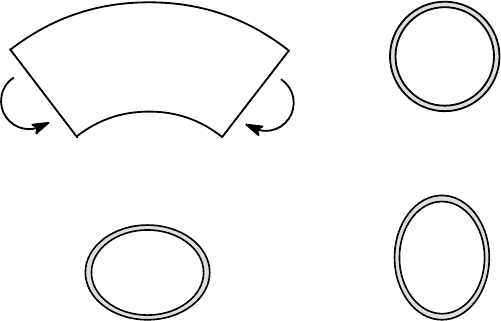
11.3 Distortion of the cross section 503
the outer flange A bending inwards and those of the inner flange B bending outwards.
As a result of this deformation, the final radius of regions A will be reduced, so that
the tensile stress is reduced, resulting in a decrease in the strain energy U stored in
the beam. A similar effect is predicted for the outward motion of the inner flanges
at B. Of course, there will be additional strain energy associated with the curvature
of the flanges in Figure 11.13 (c), but for a sufficiently thin flange, this will be small
and the net effect of the distortion will be a reduction of total strain energy. The sta-
tionary potential energy theorem (§3.5) therefore tells us to expect the beam section
to deform during bending as shown in Figure 11.13 (c). If the bending moment is
reversed in direction, the distortion is also reversed — i.e. the flanges A will bend
radially outwards and the flanges B will bend inwards.
This effect is clearly non-conservative, since by reducing the magnitude of
σ
θθ
at A and B, the distortion reduces the corresponding bending moment. If the bend-
ing moment is prescribed, additional curvature change (
∆κ
) will occur, leading to
increased bending stresses at the middle of the flanges, where radial motion is re-
strained by the web.
For thin-walled circular tubes (pipe bends), the same effect causes the section to
become oval during bending, as shown in Figure 11.14. The direction of ovalization
depends on the direction of the applied moment.
M
M
(a) (b)
(c) (d)
Figure 11.14: (a) Curved thin-walled tube loaded in bending, (b) undeformed cross
section, (c) deformed cross section for positive M, (d) deformed cross section for
negative M
The most straightforward way to estimate the distortion of a thin-walled cross
section and its effect on the maximum stress is to approximate the expected deformed
shape by an appropriate function and use the Rayleigh-Ritz method (§3.6 above).
More details of this procedure can be found in Cook and Young (1985), §§10.5,
10.6.

504 11 Curved Beams
11.4 Range of a pplicatio n of the theory
The analysis of curved beams is somewhat more complicated than that for straight
beams and hence it makes sense to use the simpler theory if the radius of curvature
is large compared with the radial thickness of the beam. A comparison of the two
theories for a beam of rectangular cross section shows that the error involved in using
the elementary theory is less than 10% as long as b/a < 1.3, where a,b are the inner
and outer radii respectively, as shown in Figure 11.3. Another way of expressing this
condition is that the radial thickness of the beam (b−a) should be less than 30% of
the inner radius.
The elementary theory is much more successful in predicting the deflections in a
curved beam, particularly if the neutral radius ˆr is used to define the ‘length’ of the
beam (see Problem 11.3). For example, the error in the predicted stiffness of a beam
of rectangular cross section, compared with the curved beam result, is less than 10%
for b/a <14.
The curved beam theory is itself approximate, since equation (11.3) assumes that
the radial displacement u
r
is independent of r and we showed in §11.2 that the radial
stress
σ
rr
(and hence the strain e
rr
) is non-zero. Fortunately, an exact solution to the
bending problem can be obtained for the rectangular cross section
4
and a comparison
with the curved beam theory
5
shows that the latter predicts a maximum stress within
10% of the exact value as long as b/a <11.
We conclude that the curved beam theory is useful in the range 1.3 < b/a < 11.
However, in a design problem, it is usually sensible to use the elementary theory
first to obtain an estimate of the maximum stress even in this range. If the result is
very low relative to the allowable stress
σ
all
(e.g. if
σ
max
/
σ
all
< 0.2), the extra effort
involved in a curved beam calculation is not justified.
11.5 Summary
In this chapter, we have shown that the stress distribution in a curved beam due to
a bending moment differs from that in a straight beam of similar cross section, and
the neutral surface is displaced towards the axis of curvature. The inner radius of the
beam acts as a stress concentration, causing an increase in the local bending stress.
Radial stresses as well as circumferential stresses are obtained and thin-walled
cross sections may experience significant distortion.
The elementary bending theory gives a good estimate of the maximum stresses
and the deformation except when the radius of curvature of the beam is comparable
with the cross-sectional dimensions.
4
J.R. Barber (2010), Elasticity, Springer, Dordrecht, Netherlands, 3rd edn., Chapter 10.
5
R.D. Cook and W.C. Young (1985), Advanced Mechanics of Materials, Macmillan, New
York, §10.3.
